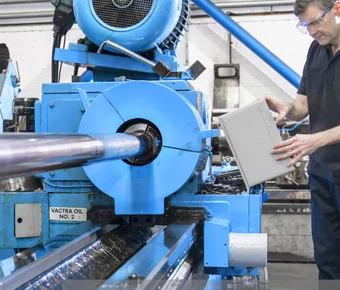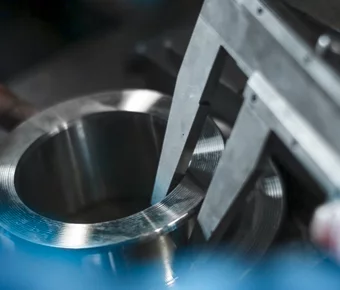1.4845 || AISI 310S/H
Heat-resistant austenitic chromium-nickel steel
The 1.4845 is among the heat-resistant austenitic chromium-nickel steels. It is well suited for an oxidizing environment at 1050 °C.
Heat-resistant Stainless Steel
General properties in processing:
- Comparable machinability to standard austenitic chromium-nickel steels
- Good weldability
- Good forgeability
Distinguishing properties:
- Scale resistant up to 1050° C, maximum application range up to 1,050°C
- Risk of embrittlement at operating temperatures 600°C<>900°C
- Good mechanical properties due to high tensile strength at higher temperatures
Corrosion resistance:
- Low: against oxidizing or reducing sulfur-containing gases
- Moderate: at temperatures >900° C against carburizing or oxygen-poor gases
Applications:
- Apparatus construction in the high-temperature range
- Automotive industry
- Construction industry
- Chemistry and petrochemistry
- Oil industry
- High-temperature apparatus construction
- Furnace construction
- Cement industry
Chemical values – Reference analysis (weight proportion in %)
| Value | Percentage |
|---|---|
| C | ≤ 0,10 |
| Si | ≤ 1,5 |
| Mn | ≤ 2,0 |
| P | ≤ 0,045 |
| S | ≤ 0,015 |
| Cr | 24,0 – 26,0 |
| Ni | 19,0 – 22,0 |
| N | ≤ 0,11 |
Mechanical values at room temperature
| Hardness HB | ≤ 192 |
| Yield strength Rp 0.2 | ≥ 210 N/mm2 |
| Tensile strength Rm | 550 – 750 N/mm2 |
| Elongation A5 | ≥ 35 % |
Creep strength
Creep strength is the mechanical initial stress that causes a material to break after a certain period of stress duration and at a constant temperature above the transition temperature under constant tensile force.
| Temperature | 1 000 h | 10 000 h | 100 000 h |
|---|---|---|---|
| Temperature: 600 °C | 1 000 h: 170 N/mm2 | 10 000 h: 130 N/mm2 | 100 000 h: 80 N/mm2 |
| Temperature: 700 °C | 1 000 h: 80 N/mm2 | 10 000 h: 40 N/mm2 | 100 000 h: 18 N/mm2 |
| Temperature: 800 °C | 1 000 h: 35 N/mm2 | 10 000 h: 18 N/mm2 | 100 000 h: 7 N/mm2 |
| Temperature: 900 °C | 1 000 h: 15 N/mm2 | 10 000 h: 8,5 N/mm2 | 100 000 h: 3 N/mm2 |
Creep limit
Creep limit is the initial stress that leads to a specified plastic deformation under constant tensile stress at a predetermined temperature and duration of stress.
| Temperature | 1 % Creep limit for 1 000 h | 10 000 h |
|---|---|---|
| Temperature: 600 °C | 1 % Creep limit for 1 000 h: 100 N/mm2 | 10 000 h: 90 N/mm2 |
| Temperature: 700 °C | 1 % Creep limit for 1 000 h: 45 N/mm2 | 10 000 h: 30 N/mm2 |
| Temperature: 800 °C | 1 % Creep limit for 1 000 h: 18 N/mm2 | 10 000 h: 10 N/mm2 |
| Temperature: 900 °C | 1 % Creep limit for 1 000 h: 10 N/mm2 | 10 000 h: 4 N/mm2 |
Coefficient of thermal expansion
Coefficient of thermal expansion for heat-resistant alloys, which have a high coefficient of thermal expansion and low thermal conductivity, leading to temperature and stress differences in a component or assembly. The coefficient of thermal expansion is expressed by the proportional length change for each degree of temperature increase, usually as 10 –6 K –1.
| Temperature | Coefficient of thermal expansion |
|---|---|
| Temperature: 200 °C | Coefficient of thermal expansion: 15,5 |
| Temperature: 400 °C | Coefficient of thermal expansion: 17,0 |
| Temperature: 600 °C | Coefficient of thermal expansion: 17,5 |
| Temperature: 800 °C | Coefficient of thermal expansion: 18,5 |
| Temperature: 1 000 °C | Coefficient of thermal expansion: 19,0 |
Standards for seamless pipes
- EN 10216-5
- EN 10297-2
- SEW 470
- ASME SA312
The information provided on this page is non-binding. It serves only as orientation.
We cannot guarantee the results in processing and application of the products.

Tables and rates

Delivery Program
Not the right steel available?
You will find the complete program for stainless steel piping systems in various materials for the highest requirements with us.







